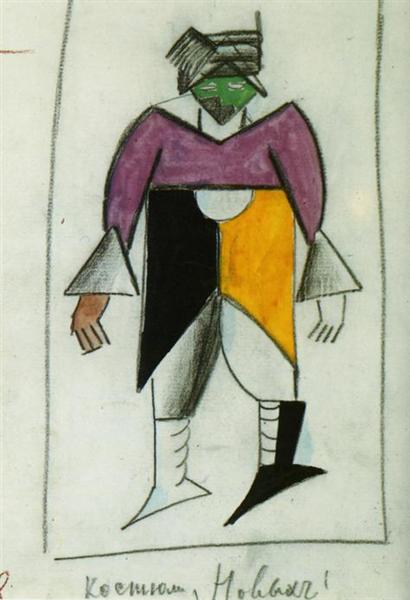Description
The painting "New Man - 1913" by Kazimir Malevich is a fascinating testimony of dynamism and experimentation of modern art in the early twentieth century. Malevich, known as the creator of suprematism, an avant -garde that privileges abstract geometric shapes and radical use of color, demonstrates in this work a transition towards pure abstraction, although with still discernible pieces of figuration.
By carefully observing the "New Man - 1913", one is first impressed by the strong geometrization of forms. The different elements that make up the human figure decompose in geometric planes, in a heterogeneity that suggests movement and energy. This disarticulation of the figure is consistent with the cube-fouturist approach that Malevich adopted during this stage of his career, influenced both by the Cubism of Picasso and Braque and by Italian futurism.
The use of color in this paint is bold and evocative. The palette of red, blue, yellow and green that Malevich uses is not random, but seeks a harmony and contrast within the apparent chaos of the forms and lines. Intense color fields, flatly applied, structure and balance compositional dynamism, suggesting a struggle between the new and old, between the machine and the human.
There is no obvious narrative or a clear representation of the "new man"; Rather, the figure seems to be an amalgam of organic and mechanical elements. This indefinition projects a deep reflection on the concept of man in the era of the machine and the advent of a future where humanity and technology coexist symbiotically. In the figure you can see a face and limbs, but treated in a schematic and fragmented way, such as challenging the viewer to rebuild the image mentally.
The perspective in the composition is almost non -existent, which is intentional and aligns with the desire to abandon the imitation of the nature and conventions of realism that European art had dominated until that moment. Instead of spatial depth, Malevich focuses on the overlap and juxtaposition of flat forms, achieving a sense of movement and expansion.
Interesting is also the theoretical background that accompanies this work. In the context of the Russian revolution, Malevich saw the "new man" not only as an aesthetic figure, but also as a social and political ideal. I was committed to the idea that art could be an engine of change, a departure from the representative towards what he called "the non-object", which appealed to an audience at a more spiritual and transcendental level.
Comparing "New Man - 1913" with other works by Malevich, such as its iconic "black square on white background" (1915), it is clear that this painting serves as a bridge between its cube -fouturist phase and its subsequent immersion in suprematism. While "new man" still maintains certain vestiges of the human form, the subsequent works of Malevich will distance themselves even more from any recognizable reference to explore the supremacy of pure sensitivity.
In conclusion, "New Man - 1913" by Kazimir Malevich is a vital work within his corpus that illustrates the crossroads between the figurative and the abstract in the artist's trajectory. It's a painting which invites you to reflect on the transformation of the human being in the modern era and its constant evolution towards new forms of existence and perception.
KUADROS ©, a famous paint on your wall.
Hand-made oil painting reproductions, with the quality of professional artists and the distinctive seal of KUADROS ©.
Art reproduction service with satisfaction guarantee. If you are not completely satisfied with the replica of your painting, we refund your money 100%.

